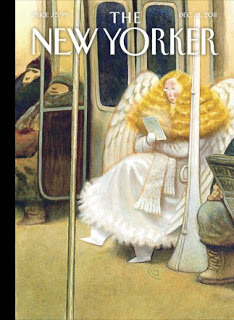The New Yorker: "What We Talk About When We Talk About Anne Frank" by Nathan Englander

December 12, 2011: "WhatWe Talk About When We Talk About Anne Frank" by Nathan Englander
I enjoyed this story more than any I've read in The NewYorker in some time. According to the Q&Awith Nathan Englander, it is the title story to a collection he's bringingout in February. And, as anyone might guess from the title, the story hasparallels with the great Raymond Carver story, "What We Talk About When We TalkAbout Love." (Here's an essay about the Carver story, for anyone who needs arefresher: "Carver'sCouples Talk about Love.") The connections to Carver's story areinteresting, but Englander's story absolutely stands on its own.
The story gives us two couples. Mark and Lauren are visitingFlorida from Israel, where they have lived for many years, having converted toultra-Orthodox Judaism (and adopted the names Yerucham and Shoshona). They cometo see Debbie, Lauren's old friend from school, and her husband, the narrator.The narrator at first is bothered by the visitors, and everything about themgrates with him. When he offers Mark a drink, though, it turns out that theycan share this, at least, and they begin to consume a bottle of vodka. Sooneveryone is getting along better, jokes are cracked, etc., and it is thenrevealed that Debbie and Lauren used to get high when they were younger. Andthat leads to the two couples smoking dope that Debbie has found in her son'sthings, which is a shock to the narrator. But as the four get high, they moveinto darker territory, eventually playing the "Anne Frank game," which isspeculating about who would and who would not protect you when the nextHolocaust comes. This is obviously a serious topic, but on the page it's quitefunny.
Debbie is somewhat obsessed with the Holocaust, and thenarrator kids her about it. It would have been a different story, of course,but I might have wanted someone to point out that if a Holocaust comes inAmerica, the signs are pointing to Muslims, not Jews, being its victims. Butthat's beside the point. The story also addresses religious purity, and thequestion of Jewish culture versus Jewish religion.
It seems to me that the magazine often saves some of itsstrongest work for the end of the year, and this story is no exception to thattrend.
Story of the year material?
Published on December 06, 2011 10:48
No comments have been added yet.



